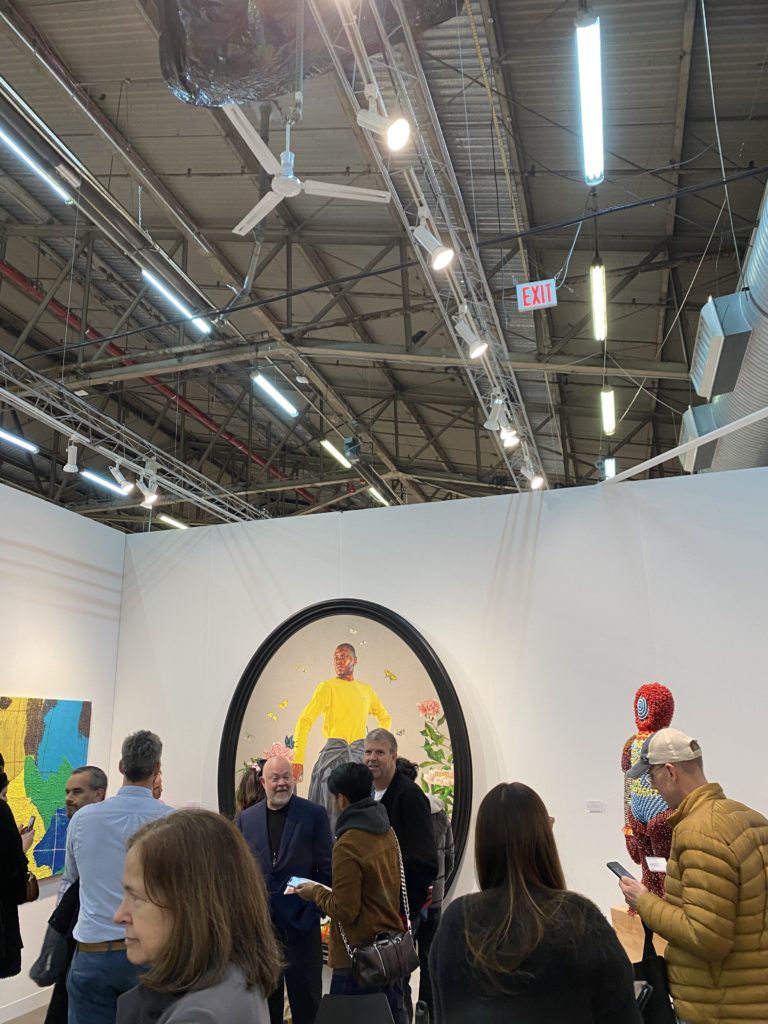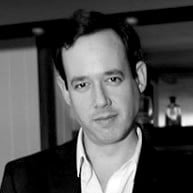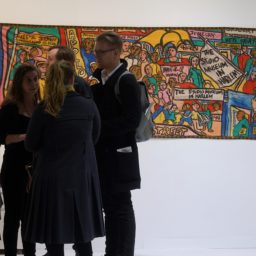There was a time—just one week ago, in fact—that, because of the impending spread of coronavirus, it was unclear if the Armory Show would happen at all. Organizers sent out a statement insisting that the annual New York fair at Piers 90 and 94 would go on, but promised that “the safety of our exhibitors and guests remains a top priority.”
Still, on Thursday, word got out that the ur-New York collectors Barbara and Howard Morse had cancelled an Armory-organized VIP tour of their home collection due to “coronavirus concerns.” It appeared that the first domino had fallen.
But instead, after that, the cancellations stopped, and the mood seemed to shift: Now everyone was rooting for the Armory show, hoping that it would not succumb to the outbreaks that led to the cancellation of Art Basel Hong Kong, which was scheduled for later this month, and the MCH-owned Baselworld watch fair at the end of April, and the postponement of the Venice Architecture Biennale until late August.
On Wednesday morning, the VIP preview was anything but empty. In the opening hours the aisles were stalked by a healthy stream of collectors from across the east coast—including Susan and Michael Hort from New York, Barbara and Aaron Levine from Washington, DC, and Jorge Perez from Miami—joined by curators such as future Venice Biennale curator Cecilia Alemani and Studio Museum director Thelma Golden. The message was clear: At least for the time being, the threat of coronavirus will not keep the art world locked up in quarantine.
“Everyone was ready to come,” said Nicole Berry, the fair’s director. “Knowing that it wasn’t unsafe we decided to proceed. I don’t think it’s deterring many people. New Yorkers are strong. I don’t think it’s affected the city yet.”
That being said, a touchy-feely affair this was not. Instead of the usual handshakes and double-tap cheek kisses, greetings ranged from tasteful nods to full-on dance moves as people tried to figure out how best to acknowledge each other’s existences. It’s strange to watch a room full of grown men and women jabbing at each other with their elbows. The bathroom sinks were chockablock with people scrubbing their hands with abandon. At times the air smelled thick of knockoff Purell.
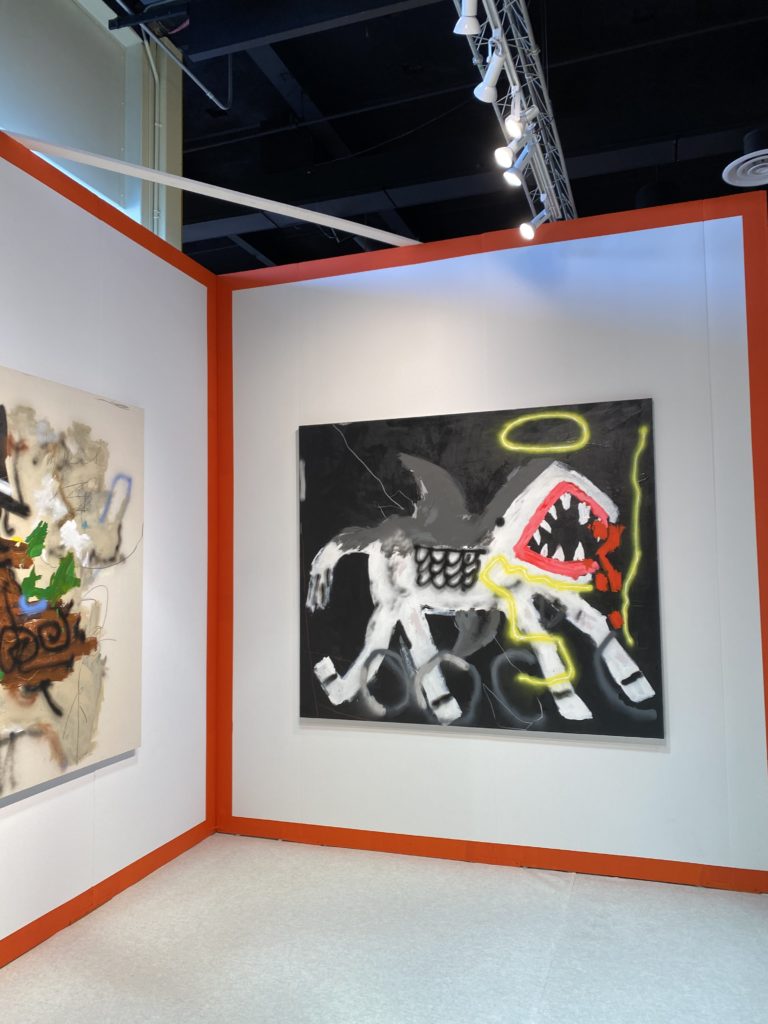
Work by Robert Nava in the booth of Sorry We’re Closed. Photo: Nate Freeman.
A global contagion isn’t the only thing the fair has going against it. Much has been made of the Armory Show’s relevance in the increasingly hectic fair calendar. As of last year, it’s been sandwiched between two fairs that have total global clout: Frieze Los Angeles—which last month managed to upstage its already successful first edition thanks to a mix of high-wattage booths, celebrity attendees, and sunny weather—and, most years, Art Basel Hong Kong. It’s hard for the Armory to compete with juggernauts, especially when it lacks the presence of so many global mega-galleries that have New York locations: David Zwirner, Hauser & Wirth, Levy Gorvy, Pace, Lisson, Perrotin, etc.
But once again, the Armory Show succeeded on its own terms, because it was a regional fair in New York City—something on the scale of, say, Art Brussels or Expo Chicago that just happened to be in the most important cultural city on earth. And like those fairs, its residents prop it up, coming for not just the opening but throughout the week, from the neighboring states and sometimes a bit farther.
“We have a really strong US base of people that come—obviously the tristate area is always going to come,” Berry said. “People are traveling, and if they can make it here they can make it here.”
And such is the reason dealers keep making the trek. Even though Roberts Projects just showed at the Felix Art Fair in its hometown of Los Angeles, it made the trek to Gotham this week and brought along serious works, including a large mixed media assemblage by 93-year-old artist Betye Saar, who just had a retrospective at the Museum of Modern Art. It was on reserve for $1.2 million—a large figure for any fair, and one of the biggest price tags of the day.
“We’ve been doing this fair for a long time, and we support each other, so we brought the best we could,” said gallery director Bennett Roberts.
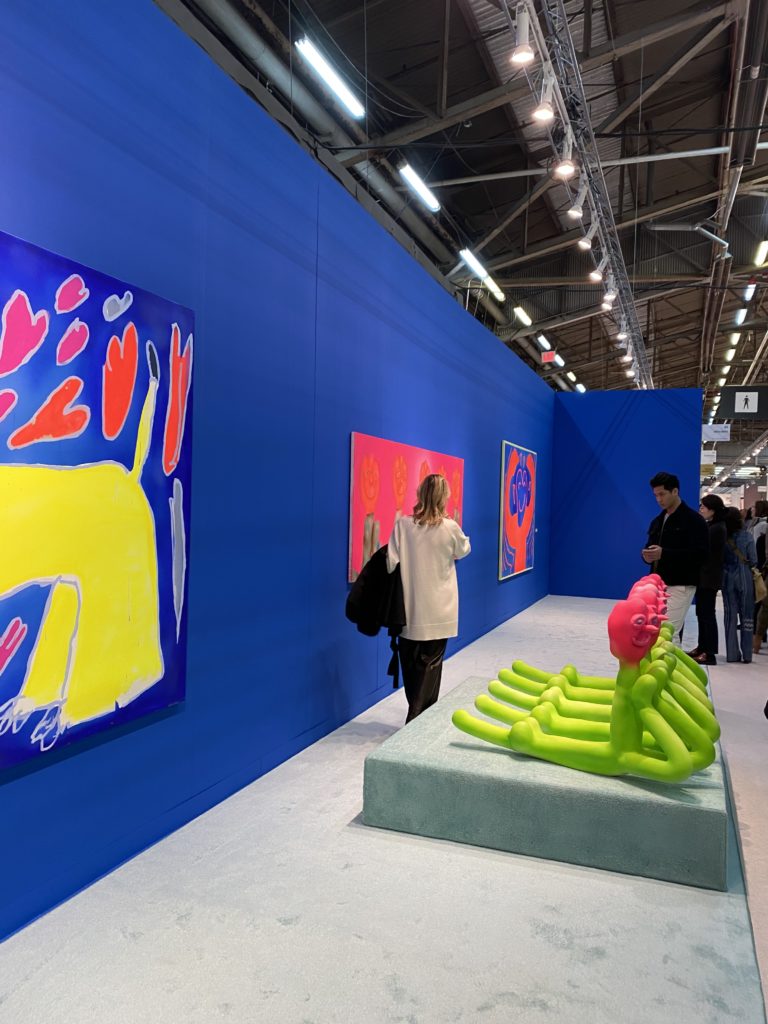
Installation view of the Jeffrey Deitch booth featuring work by Austin Lee. Photo: Nate Freeman.
Also on the booth was a gigantic new Kehinde Wiley painting that sold for $325,000, a new Jeffrey Gibson sculpture that was on reserve for $250,000, and a portrait by market darling Amoako Boafo, whose painting The Lemon Bathing Suit (2019) sold last month for $880,000 at Phillips on a high estimate of $65,000. The one now in the booth, a smoldering 2019 painting titled Tassel Earrings, sold to a Florida institution, and Roberts said a work such as this usually sells for $200,000 on the primary market.
“He’s hotter than hot,” Roberts said of Boafo, who is rumored to be using this influx of cash to buy up Ferraris and tool them around his hometown of Accra, Ghana. (Roberts did not confirm this.)
“You know, Noah Davis is one of my discoveries too,” Roberts went on, referring to the late painter who at the same time as the fair had a painting sell at Phillips for $400,000 over a high estimate of $80,000. “So people are asking me who to buy next. And I’m not a magician, but I’m pretty good. My odds are pretty good—I’m about a six out of ten. In baseball if you’re three out of ten, you’re one of the all-time greats.”
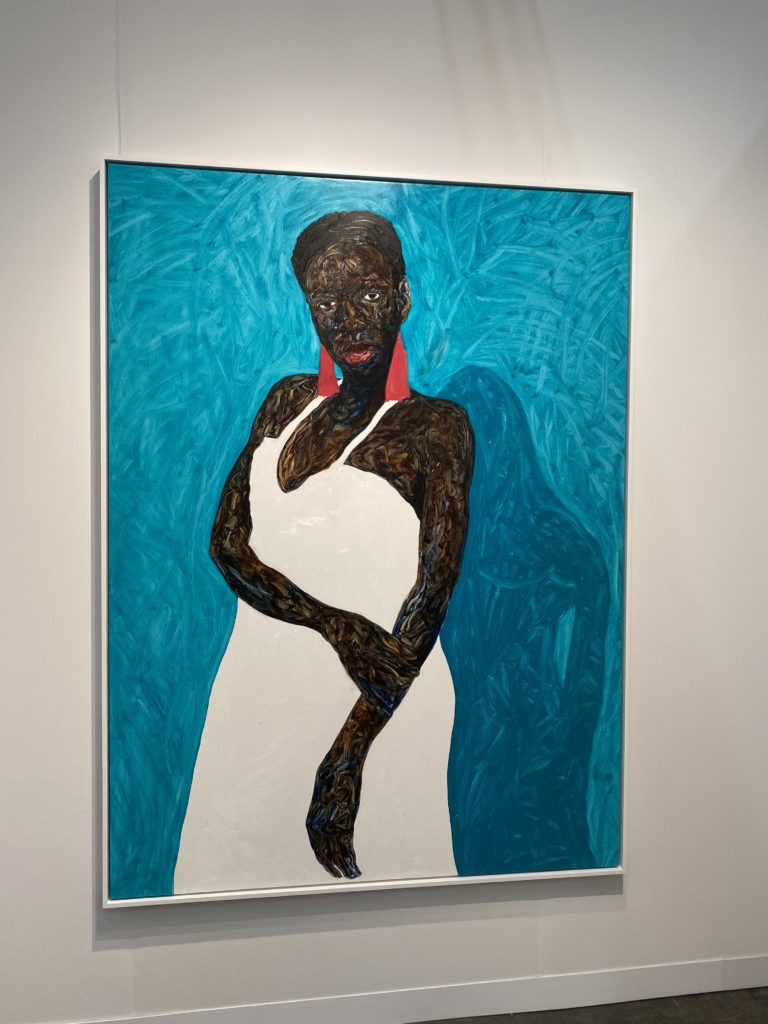
A work by Amoako Boafo in the Roberts Projects booth.
At the booth of Brussels gallery Sorry We’re Closed in the fair’s Focus section, located in Pier 90, director Sebastien Janssen said he brought the big splashy new paintings by Robert Nava because the artist is based in Brooklyn, and he’s never had a solo booth here.
“I wanted New Yorkers to see him in the best way possible,” Jannssen said.
He added that there’s such demand for the works that the buyers, all but one of whom were from North America, had to endure a waiting list until they got a work, at prices between $25,000 to $35,000.
Jeffrey Deitch also brought a young-ish Brooklynite, the charming maximalist artist Austin Lee, and sold all of the big, neon-glowstick-colored, meme-influenced paintings by early afternoon.
In addition to those sales, Zeno X sold a Luc Tuymans for $700,000 and Bortolami sold works by Mary Obering for $430,000. Kayne Griffin Corcoran sold a Mary Corse work for $280,000. Kasmin sold a bronze work by Lynn Chadwick (whose estate used to be repped by the now-defunct Blain|Southern) for $130,000, while Swiss gallery von Bartha sold Imi Knoebel’s Anima Mundi 8-4 (2019) for between $110,000 and $130,000.
Sean Kelly, a longtime Armory Show exhibitor, said that even though his gallery is basically in the neighborhood, he brought work by nearly every artist on his roster, and set up a special sub-booth to display photographs taken by Dawoud Bey that make up the series “Harlem, U.S.A., 1975-1979.” They haven’t been shown in the city since they debuted at the Studio Museum in Harlem in 1979. He said he chose this fair to debut works to coincide with the traveling Bey retrospective that’s currently at the San Francisco Museum of Modern Art—but also to acknowledge that, historically, he’s done well at the fair.
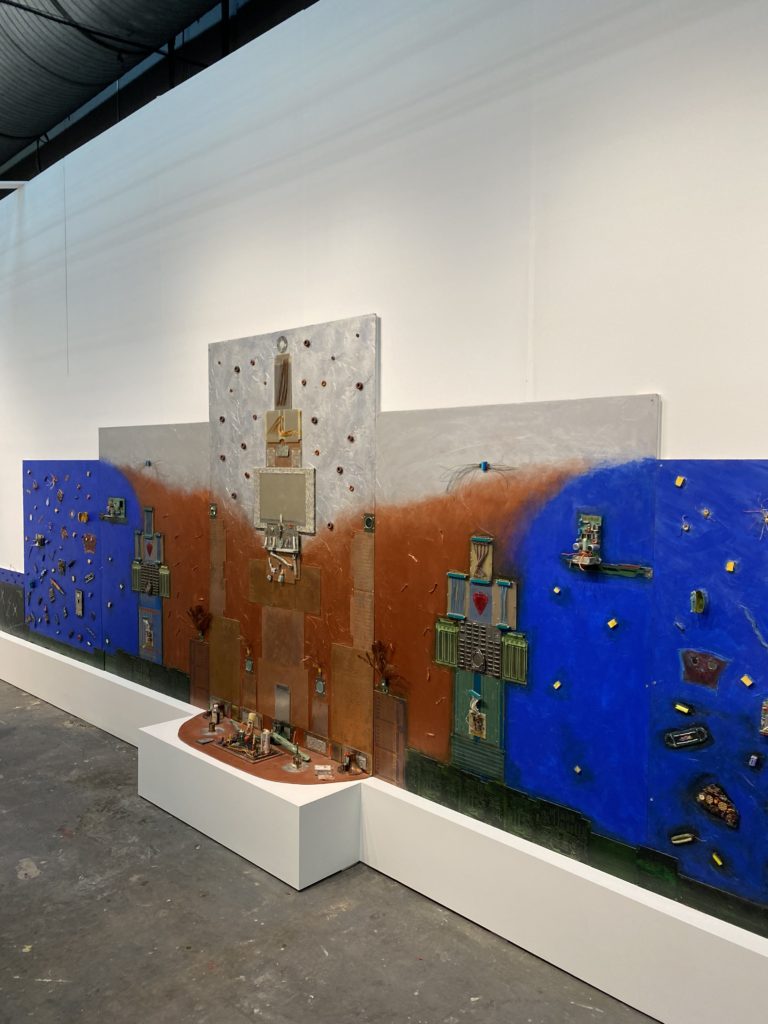
A Betye Saar work in the Roberts Projects booth.
“Why would I do the fair if my gallery is a few blocks away?” Kelly asked rhetorically. “Because it’s a five-day fair—people come back every day, we do business every day. If someone wants to turn up their nose at that, they can, but it’s ridiculous.”
He said that he had sold prints of the Dawoud Bey photos for between $7,000 and $20,000, depending on the edition. Paintings by Hugo McCloud sold for between $75,000 and $95,000.
After Kelly and I were done chatting, he stuck out his arm. Without realizing what we were doing, all of a sudden, I grabbed his hand; we were shaking hands. I immediately recoiled, but Kelly just laughed.
“This whole thing is ridiculous,” he said. “I’m glad you went for the shake.”
